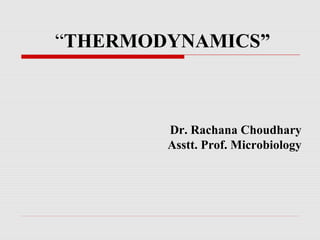
Thermodynamics
- 1. Dr. Rachana Choudhary Asstt. Prof. Microbiology “THERMODYNAMICS”
- 2. SYNOPSIS Interoduction Defination Terms used in chemical thermodynamics Internal energy Law’s of thermodynamics Difference between 1st and 2nd low of thermodynamics FREE ENERGY OR GIBB’S FREE ENERGY(G) Energy crises in nature Conclusion Refrence
- 3. INTRODUCTION The word ‘thermodynamics’ means study of flow of heat. DEFINATION The branch of physical chemistry which deals with the energy changes accompanying a chemical reaction.
- 4. TERMS USED IN CHEMICAL THERMODYNAMICS System- Surroundings. Types of system- - Open system - Closed system - Isolated system
- 5. Physical properties of a system- 1.Intensive properties- eg. – temperature, pressure, viscosity, surface tension, refractive index, specific heat, density, etc. 2.Extensive properties- eg.- mass, volume, energy, heat capacsity, entropy, Gibb’s free energy, ect. Thermodynamic process- -Isothermal process -Adiabiotic process -Isobaric process -Isochoric process -Reversible process -irreversible process
- 6. INTERNAL ENERGY Every substance possesses a definite amount of energy which depends upon its chemical nature, temperature, pressure and volume. This is called internal energy (E). Etotal= Et+Er+Ev+Ee+En+Ei ∆ E= E2 – E1
- 7. LAW’S OF THERMODYNAMICS First law of thermodynamics or law of conservation of energy- -Frist stated by Meyer and Helmholtz in 1840. “Energy can neither be created nor destroyed although it can be transformed from one form to another”. OR “The total amount of the energy of the universe is a constant”.
- 8. E2 = E1 + q + w ………….(1) E2 - E1 = q+w ……...(2) E = q + w
- 9. E2 = E1+q + w ………….(1) E2- E1= q+w ..………...(2) ∆E = q + w If work is done by the system, then ∆E = q – w +q= heat absorbed by the system. –q= heat liberate by the system. +w= work done on the system. –w= work done by the system.
- 10. ENTHALPY(H) AND ENTHLPY CHANGE(∆H) Enthalpy is the amount of heat stored in the system under particular condition and is termed as heat content of the system. H=E+PV ………(1) Enthalpy change, ∆H= H2-H1 On constent P, Hp, Ep, and Vp. ……(A). Heat absorp by the system on constent P, then HR, ER, and VR. ………(B). Eq. ( B)- Eq. (A ), ∆H=∆E+P∆V
- 11. SPONTANEOUS PROCESS Spontaneous processes are those that can proceed without any outside intervention. Processes that are spontaneous in one direction are nonspontaneous in the reverse direction.
- 12. ENTROPY(S) Entropy can be thought of as a measure of the randomness of a system. Sgas >Sliquid>Ssolid Like total energy, E, and enthalpy H, entropy is a state function. Therefore, ∆S = Sfinal − Sinitial
- 13. SECOND LAW OF THERMODYNAMICS The entropy of the universe does not change for reversible processes and increases for spontaneous processes. Where, ∆S total >0 (Irreversible (real, spontaneous): ∆S total =0 (equillibrium) Reversible (ideal): ∆S total <0 non spontaneous
- 15. THIRD LAW OF THERMODYNAMICS Nernst(1906) The entropy of a pure crystalline substance at absolute zero is 0.
- 16. DIFFERENCE B/N 1st and 2nd law 1st law is conserned with the accounting of the various kinds of energy involved in a given process. 2nd low is conserned with the availabity of the energy of a given system for doing useful work. Combining the 1st and 2nd law of thermodynamics (Gibb’s in 1878) ∆G=∆H-T∆S
- 17. FREE ENERGY OR GIBB’S FREE ENERGY(G) In 1878 J.V. Gibb’s created the free energy function by combining the 1st and 2nd law of thermodynamics. ∆G = ∆H – T(∆S) Free energy change (∆G ) G1, H1 and S1 G2, H2 and S2 A/C to Gibb’s G1, H1 and S1 ….......(a) G2, H2 and S2 ……...(b) where T is constant. Eq. (b)- Eq. (a), ∆G = ∆H – T(∆S)
- 18. FREE ENERGY CHANGES AND SPONTANEITY OF A PROCESS For spontaneous process- ∆Stotal =∆Ssystem+ ∆ Ssurroundings or ∆Stotal = ∆Ssystem+(-q/T) system (qpsurroundings= -qpsystem) or ∆Stotal= ∆S–∆Η/Τ (qp = ∆Η) Multiply of –T on both side, −Τ∆Stotal= −Τ∆S+ ∆Η Or −Τ∆S = ∆Η −Τ∆S For Gibb’s Free energy, ∆G = ∆H – T(∆S) (For spontaneous process-)
- 19. Predicting Sign of ΔG in Relation to Enthalpy and Entropy ΔH ΔS ΔG - + + - - - + + Always negative (spontaneous) Always positive (nonspontaneous) Neg. (spontaneous) at low temp Pos. (nonspontaneous) at high temp. Pos. (nonspontaneous) at low temp Neg. (spontaneous) at high temp.
- 20. CONCLUSION The direction of a reaction weather from left to right or vise versa. The accomplishment of work weather useful of not. Weather the energy for driving a reaction must be deliverd from on external source.
- 21. REFRENCE A text book from:- - Fundamental of biochemistry- Dr. A C Deb. - Fundamental of biochemistry (Multicolored Edition) by J.L. Jain. Principle of biochemistry by Nelson, Cox and Lehninger.
- 22. THANKYOU